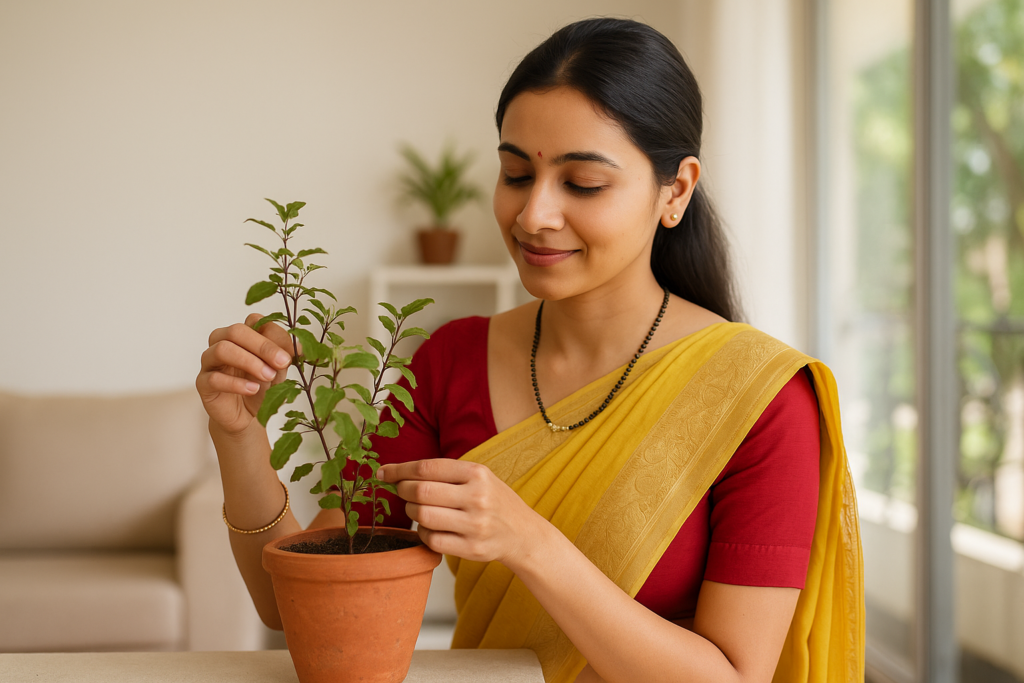The tulsi plant, often referred to as holy basil, is not just another leafy green; it helps the body cope with stress and adapt to change. In many homes, especially in India, it is a part of everyday life, a symbol of protection, purity and peace.
But if you are wondering where the best place to keep a tulsi plant is in your home, you are not alone. We have you covered. Whether your goal is spiritual, aesthetic or simply practical, placing your tulsi in the right place can make a significant difference to you and your life.
The spiritual and natural power of tulsi
Long before wellness trends and indoor plant guides, tulsi was already cherished. Its presence is said to purify the air and the energy of the space. But beyond tradition, it’s also a strong natural healer, with antibacterial and calming properties.
Having tulsi at home is like welcoming a quiet presence that asks for little and gives a lot.
The ideal direction to place tulsi
If you’re serious about getting the most out of your tulsi, placement matters.
- East: the most recommended direction. Tulsi thrives here with the morning sunlight, and according to vastu, this brings harmony and prosperity.
- Northeast: a sacred and peaceful zone in most vastu systems. Ideal if you use the area for meditation or morning rituals.
- North: another favorable spot, especially if your home layout doesn’t allow access to eastern light.
The idea is to align the tulsi with spaces that bring in clean, natural light—especially in the early hours of the day.
Where not to place tulsi
Yes, there are places tulsi doesn’t like.
- South-facing corners tend to carry heavier energy, and they don’t provide the sunlight tulsi prefers.
- Bathroom windows or near trash bins? avoid. These areas can disrupt the pure energy tulsi carries.
- Dark, enclosed spaces won’t support its growth—or its energy.
Remember, tulsi isn’t a decorative plant. It’s a living presence that responds to space and energy.
Practical spots in a modern home
You don’t need a temple or a big courtyard to keep tulsi happy. Even in apartments and city homes, there are creative and respectful ways to place your plant.
Balcony with morning sun
A small tulsi pot on an east-facing balcony does wonders. If your mornings are sunny and breezy, your tulsi will thank you.
Kitchen windowsill
If you love cooking with fresh herbs, this is a bonus. Tulsi near a well-lit kitchen window keeps the energy fresh and the aroma alive.
Near your prayer area
If you have a small altar or meditation corner, adding tulsi can deepen the space’s vibration. Just make sure it still gets good light.
How to care for your tulsi plant
Once you’ve placed it well, tulsi won’t ask for much—but here’s how to keep it thriving:
- Sunlight: 4–6 hours a day is perfect. It loves soft morning rays.
- Watering: a little daily or every other day, depending on the season. Keep the soil moist, not soaked.
- Clean environment: sweep around it. Keep the area tidy. It’s a sign of respect and helps the plant stay healthy.
- Potting: use natural clay pots if possible. It allows the roots to breathe and retains the earthy balance tulsi enjoys.
More than a plant, it’s energy
When you ask, “which is the best place to keep tulsi plant at home,” you’re really asking something deeper: how do I invite harmony, health, and balance into my space?
Tulsi does that—not just with its leaves, but with its quiet, grounded presence.
So choose a corner that gets light, feels calm, and allows the tulsi to grow with dignity. It’ll return the favor in quiet, powerful ways.






